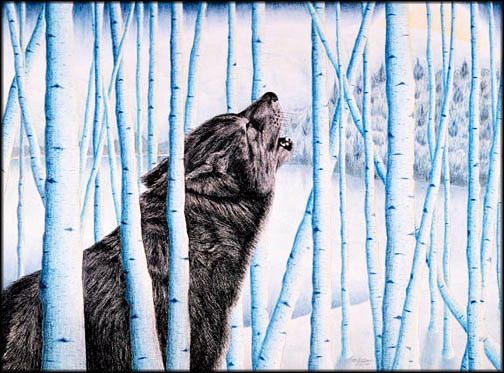This piece is the second in the series about King Philip. In the foreground is Wachusett Lake, today a reservoir for the city of Fitchburg, Massachusetts. Near this spot is Redemption Rock, the site where the English captive and narrative writer, Mary Rowlandson, was redeemed during King Philip’s War. In the background is Mount Wachusett, the sacred mountain of the Nipmuck people.
King Philip’s whereabouts, after the English attacked the Narragansett fort (see the description for the Guardians), are not well known. Joseph Dudley, an officer on General Josiah Winslow’s staff claimed, in his report of the event, that “Philip was seen by one… under strong bodyguard.”
It’s generally believed he went to upstate New York, at Schaghticoke, on the Hoosic River above Albany, to get assistance from the Mahicans in his struggle to reclaim his ancestral lands. While there, his people were attacked by a group of Mohawks, who were abetted by Governor Andros of New York. Some accounts indicate that only 40 of Philip’s 400 warriors survived. No doubt battered and dispirited by this event, he worked his way back east, to Winnimissett, just west of Mount Wachusett. This place, some seventy miles north of the Great Swamp Fight massacre in Kingston, Rhode Island, was the stronghold of his allies the Nipmuck.
Throughout the previous summer and fall campaigns, Native forces led a wide-ranging crusade against the English, successfully advancing on frontier towns like Brookfield, in central Massachusetts, and Springfield, Deerfield, Northfield, and other settlements in the Connecticut River valley. The English attack upon the Narragansett fort was demoralizing to the Indians but this only complicated matters for the colonist. The previously neutral Narragansett were now fully committed to war. With the coming of spring, the combined native forces, made up predominantly of Wampanoag, Narragansett, Nipmuck, and Nashaway, directed their attacks on English towns much closer to the Bay Colony’s seat of power, such as Lancaster, Groton, Sudbury, Medfield, Marlborough, and even Plymouth. The English lost many of their homes, farms, and livestock, but such things were replaceable. When the Indians lost their land, however, they also lost their world. Now they had only their lives as assets, and each loss was a costly one.
At the beginning of May, the Natives held a great dance near the southern end of Wachusett Lake, somewhere along the distant shore depicted in this piece. But the spiritual forces they were invoking were confronted by and equally formidable force: food and supply shortages. In addition to the large population of fighting men, there were also women, children and the elderly on the march. On the move since the previous summer when they left Mount Hope, they had been unable to harvest their crops and had endured great suffering during the final months of the conflict. One Indian captive related to the English that “more had died of starvation than from the English sword.”
The English captive, Mary Rowlandson, described in her narrative of the war that the Indians “would eat that, that a hog or a dog would hardly touch;… The chief and commonest food was ground nuts: they ate also nuts and acorns, artichokes, lily roots, ground beans, and several other weeds and roots, that I know not. They would pick up old bones, and cut them into pieces at the joints, and if they were full of worms and maggots, they would scald them over the fire to make the vermin come out, and then boil them, and drink up the liquor, and then beat the great ends off them in a mortar, and so eat them. They would eat horse’s guts, and ears, and all sorts of wild birds which they could catch:… yea, [even] the very bark of trees.”
On another occasion she relates that “at night we came to an Indian town, and the Indians sat down by a wigwam discoursing, but I was almost spent, and could scarce speak. I laid down my load, and went into the wigwam, and there sat an Indian boiling of horse’s feet (they were wont to eat the flesh first, and when the feet were old and dried, and they had nothing else, they would cut off the feet and use them). I asked him to give me a little of his broth, or water they were boiling in; he took a dish and gave me one spoonful of samp, and bid me take as much of the broth as I would, then I put some of the hot water to the samp and drank it up, and my spirit came again.”
Only the Narragansett had ample food reserves, but they were back in Rhode Island, hidden in caches. People were dispatched to retrieve them and many were killed on the way in skirmishes with the English. Canonchet, Philip’s ally and the Great Sachem of the Narragansett (and likely the leader of the combined fighting forces) was captured in one of those encounters. His head eventually went to Hartford where it was displayed by the colonist as a trophy of war.
Some believe that Philip knew this was the beginning of the end. His people were tired, suffering from malnutrition and discouraged by the many losses of friends and relatives; but there was no turning back.
In this piece, the wolf, which some believe was Philip’s totem, represents his animistic spirit. He cries out to the distant mountain, to the spirit of his ancestors, the ancient caretakers of his age-old homeland, that they hear the cry of his people. The spirits as well as Philip fathom the desperation of the situation. A dark sky looms over the mountain, indicative of darker and more uncertain times to come.
